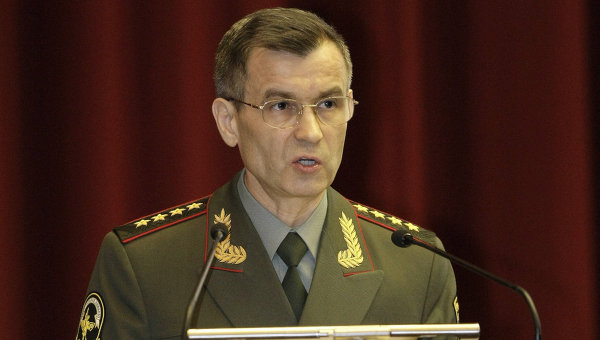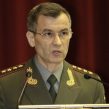
Troop Redeployments in the North Caucasus Point to More Trouble on the Horizon
Publication: Eurasia Daily Monitor Volume: 9 Issue: 63
By:

Judging by the number of trips Russian Interior Minister Rashid Nurgaliev has made to Chechnya, one might think that Russia consists of only Chechnya and Moscow. Otherwise, these visits, sometimes made as often as twice a month and accompanied by mandatory visits paid to Akhmad Kadyrov’s grave in the village of Tsentoroi in Kurchaloi district of Chechnya’s foothills, are difficult to explain (Grozny TV station Grozny, March 24).
Nurgaliev had already paid a visit to the Chechen Republic earlier, on March 5, when he held a meeting during which the current security situation in the republic was assessed and new plans were being drawn up. First and foremost, the issue of providing security in Chechnya during the spring-summer period was discussed (RIA Novosti, March 5). The fact that this event was held pointed to the problems the authorities might encounter as the rebels become more active in the spring. It is strange that the Russian Interior Minister missed the fact that for the second year in a row the insurgents have paid no attention to the seasonal changes – the time of year no longer seems to have an impact on insurgent activity. This is part of the rebels’ new tactics, since their capacities now allow them to operate year round.
During his latest visit Nurgaliev awarded the 46th brigade of the Interior Ministry the Zhukov medal – the highest state award (www.vesti.ru/doc.html?id=750976). According to the Minister, the 46th brigade has taken part in 15,000 operations since its inception in 2000 – amounting to three to four operations per day over its 11-year lifespan. Minister Nurgaliev also announced in Grozny that the President of Russia decreed assigning Akhmad Kadyrov’s name to the 141st special motorized regiment (aka the Sever battalion) within the 46th brigade (www.grozny-inform.ru/main.mhtml?Part=8&PubID=32739). Russian Interior Ministry units do not normally receive honorary names, so this instance is nothing other than a nod to Ramzan Kadyrov.
Just prior to his arrival in Chechnya, Nurgaliev announced the redeployment of several detachments of Interior Ministry troops from Chechnya to Dagestan (BBC Radio, March 19). The move did not simply mandate the withdrawal of excess troops from Chechnya. Rather, the country’s leadership apparently decided to set up an Interior Ministry temporary operational group in Dagestan. Thus, 12 years after the start of the second war in Chechnya in 1999, a mechanism for coordinating of different counter-insurgency units based on the Chechen example has been established for Dagestan, to be headed by Colonel Oleg Kizhaev.
Russian officials believe this move will help stabilize the worrisome situation in the republic. The authorities finally realized that they are not in control of the situation and militant actions cannot be halted by isolated Dagestani Interior Ministry special operations. And that is despite the fact that last year, the decision was made to create, as in Chechnya, special units consisting of local law-enforcement personnel to fight the militants. At that time the government plan was to create structures made up of 5,497 Dagestani Interior Ministry officers, 150 special units officers, 878 Russian Interior Ministry troops, including 500 officers from the special units, and ten crews of road police (www.mvd.ru/news/show_93213/, June 27, 2011).
At the same time, special police unit reinforcements were sent to Dagestan from other regions of the Russian Federation. So the redeployment of troops from Chechnya to Dagestan should be regarded as the government’s attempt to keep the situation under control by all possible means. According to local eyewitness reports from Dagestan, the convoy of military vehicles from Chechnya stretched over many kilometers, and the redeployment took several days. On the first day alone, over 300 military vehicles were counted on their way to Dagestan, including APCs, military trucks and automobiles. The equipment went to Dagestan’s Karabudakhkent district, but government sources said the military reinforcements would be stationed in the most hazardous districts of the republic. The troops are likely to be stationed in Karabudakhkent, Buinaksk, Sergokala or Untsukul districts, but may also be used in other districts as needed (https://rss.novostimira.com/n_2362492.html). The number of redeployed troops can only be approximated, since Russian sources never provide accurate figures. The troops may number anywhere from 25,000 to 30,000 men. The fact that the newly deployed reinforcements will fight the militants and relieve the Dagestani police of this task indicates Moscow’s distrust of the local authorities (https://chernovik.net/news/484/POLITICS/2012/03/25/13296).
In any event, Chechnya’s experience shows that no matter how numerous the size of military forces being deployed, they are usually helpless against small groups of insurgents. Therefore, the redeployment of troops should be seen in the context of a possible deterioration of the situation on the southern borders of the Russian Federation as Moscow’s only response to a regional insurgency is to deploy massive amounts of ground forces – something they tried unsuccessfully in Afghanistan in 1979. The situation on the southern borders of the Russian Federation is no different and the instability in Dagestan should be viewed as inter-related to the other ongoing problems in the North Caucasus. Interestingly enough, it should be noted that the Russian global navigation system, GLONAS, is rapidly being deployed with Russian naval forces on the Caspian Sea coast of Dagestan – a development that has nothing at all to do with fighting the insurgency (https://voennovosti.ru/2012/03/v-rajonax-baz-vmf-na-yuge-rossii-budet-razmeshheno-bolee-tridcati-stancij-glonass/). Iran is three times closer to Dagestan than to Rostov-on-Don, so the Russians cannot be undisturbed by the possibility of a worsening of the situation in the South Caucasus.
The redeployment of military forces from Chechnya to Dagestan should be regarded not as an unexpected move, but rather as a logical response to the high level of rebel activity, with the authorities starting to realize that it could lead to the disintegration of the country. This scenario was becoming especially threatening against the backdrop of the deteriorating situation in Iran and fears of a possible deployment of NATO troops to Georgia, which is being repeated in the Russian media. The combination of all these trends makes this region particularly vulnerable, and last year’s redeployment of the 33rd mountain infantry brigade from Botlikh, Dagestan to Maikop, Adygea underscores Moscow’s need to strengthen its presence in the Northwest Caucasus in anticipation of the 2014 Sochi Olympics. The redeployment to Maikop only weakened the Russian military forces on the Dagestani portion of the Russian border. Because of this, Moscow had to come up with a plan to counter the rising insurgency in Dagestan, and Nuragaliev’s shuttle diplomacy back and forth to Chechnya now appears to have been laying the groundwork for the Kremlin’s massive redeployment of forces to Dagestan.
Therefore, twelve years after the start of the war in Chechnya, Moscow has decided to apply its Chechen experience to solving the conflict in Dagestan. However, today’s Dagestan is not the same as Chechnya in 2000. The problems of contemporary Dagestan are a can of worms, of which radicalization of the population is becoming the most significant one. And the worst part of it all for Moscow is the involvement of a portion of the Dagestani intelligentsia in backing the insurgent movement. Dagestan exceeds all other regions of the North Caucasus in its importance. Consequently, Moscow is prepared to resort to any methods to keep Dagestan under control and prevent the process of actual disintegration of Russia, which may start in the south.




